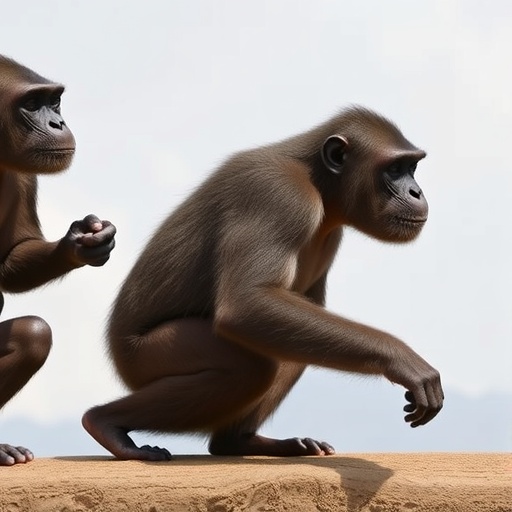Humans have long captivated scientists with the remarkable size and complexity of their brains, accompanied by notably flat facial structures compared to other apes. A groundbreaking study from University College London reveals that these distinctive craniofacial traits evolved at an unexpectedly rapid pace relative to our closest primate relatives. Through sophisticated computational analysis of three-dimensional skull models, the research team uncovered that human skull evolution occurred at nearly twice the rate seen in other great apes, underscoring the dynamic evolutionary pressures shaping our species’ unique anatomy.
Published in the Proceedings of the Royal Society B, the study meticulously examined craniofacial divergence among hominids—comprising humans, gorillas, chimpanzees, and orangutans—and compared them to the more morphologically conserved lesser apes known as hylobatids or gibbons. Using cutting-edge virtual reconstructions derived from CT scans, the researchers parsed the skulls into four anatomical regions: upper face, lower face, cranial front, and cranial back. This granular approach enabled precise numerical quantification of morphological differences between species, representing the most comprehensive 3D comparative analysis of primate skull structure to date.
The evolutionary split between hominids and hylobatids occurred approximately 20 million years ago. Over this vast timespan, hominids underwent a dramatic explosion of anatomical diversity, markedly altering craniofacial patterns, whereas hylobatid skull morphology remained surprisingly uniform. Despite this wide disparity, the study identified humans as the fastest-evolving species within hominids, suggesting potent selective forces specifically targeting the craniofacial traits that support enhanced cognitive capacities.
Human skulls diverge fundamentally from those of other great apes, featuring relatively large, globular braincases paired with flat faces exhibiting reduced prognathism. Conversely, most great apes maintain large, projecting faces with comparatively small brain volumes. Interestingly, gibbons share the flatter facial profile and rounded cranial vault seen in humans, but possess considerably smaller brains, offering an intriguing morphological parallel that nonetheless lacks the neurological expansion characteristic of our species.
By utilizing the evolutionary stasis and low morphological variability of lesser apes as a baseline control, the research team was able to pinpoint that humans accumulated craniofacial changes at nearly double the expected evolutionary rate. This acceleration indicates that factors beyond ordinary genetic drift and standard natural selection are likely influencing the trajectory of human craniofacial evolution, potentially including intricate social and cognitive drivers.
The rapid expansion of brain size in humans is frequently hypothesized to underlie our unparalleled cognitive abilities. However, the researchers caution that this neuroanatomical evolution is not the sole factor shaping skull morphology. Social selection may also have played a crucial role, whereby certain craniofacial features could confer advantages in social hierarchies or mate selection. For example, gorillas exhibit the second fastest craniofacial evolutionary rate among great apes, but their brains remain relatively small. In gorillas, the enlarged cranial crests are believed to signal social status, hinting that similar social dynamics could have influenced human craniofacial form.
This multifaceted evolutionary picture suggests that the interplay between neurological demands and social environmental pressures may have jointly propelled the rapid development of human skull characteristics. The combination of a larger brain accommodated by an expanded cranial vault and the reduction of face size to optimize bite forces and jaw function likely intertwined with the subtleties of human social complexity in shaping our anatomy.
From a methodological standpoint, the study represents a leap forward in evolutionary biology by leveraging advanced computational modeling techniques. Through detailed 3D virtual skull replicas, researchers were able to systematically dissect morphology with unprecedented accuracy, enabling robust interspecies comparisons and evolutionary rate estimations. This empirical approach highlights the power of integrating paleoanthropology with digital morphometrics to unravel the nuances of primate skull evolution.
The findings provide a refined temporal framework for understanding when and how the critical adaptations linked to human brain expansion and craniofacial reduction emerged in the evolutionary timeline. By precisely quantifying divergence rates, the study offers compelling evidence that human evolutionary history is marked by distinctive accelerations in anatomical change not mirrored in other ape lineages, further emphasizing our unique position in the primate family tree.
Fundamentally, this research enriches our comprehension of how evolutionary mechanisms sculpt morphology in response to complex functional and social demands. It underlines the importance of both natural and sexual selection forces operating in concert to generate the extraordinary anatomical features defining Homo sapiens. Ultimately, these insights shed light on the intricate evolutionary journey behind human cognitive and social sophistication.
Future studies could build upon this foundation by incorporating genetic data and fossil record correlations to trace the selective landscapes influencing skull morphology. Moreover, exploring the developmental biology underpinning craniofacial variation may reveal the mechanistic pathways facilitating rapid evolution. Such interdisciplinary work promises to deepen our grasp of the evolutionary dynamics shaping the human form.
This study not only challenges existing paradigms regarding the tempo and mode of human evolution but also opens avenues for exploring how social behavior intertwines with anatomical change. By marrying computational modeling with evolutionary theory, the research exemplifies modern approaches to decoding our complex biological heritage, capturing the imagination of both scientific and public audiences alike.
Subject of Research: Not applicable
Article Title: Accelerated evolution increased craniofacial divergence between humans and great apes
News Publication Date: 21-Oct-2025
Web References:
DOI link: http://dx.doi.org/10.1098/rspb.2025.1507
References:
Gomez-Robles, Aida, et al. “Accelerated evolution increased craniofacial divergence between humans and great apes.” Proceedings of the Royal Society B, 22 October 2025.
Image Credits: (c) Dr Aida Gomez-Robles (UCL Anthropology)
Keywords: Human evolution, Human adaptation, Paleoanthropology, Anthropology, Anthropogenesis, Human diversity, Primates, History of life




